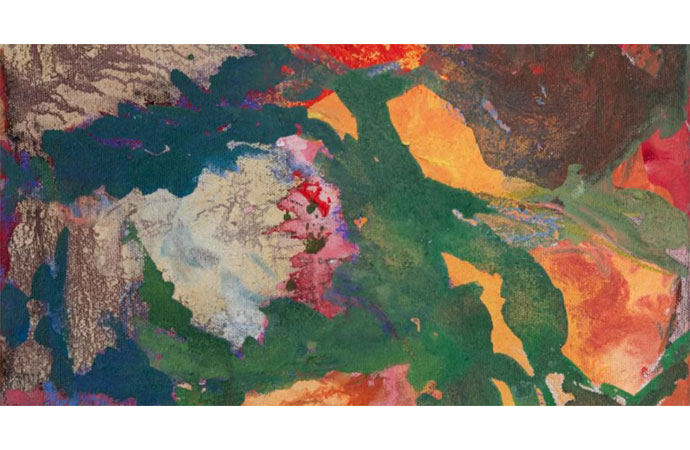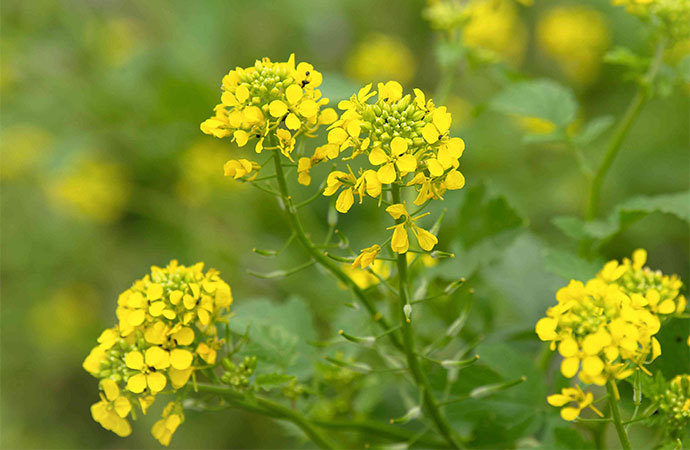Essays

Pied Bushchat on stone. Photo: Enam Ul Haque
We were thrilled to spot a strange black bird on a painted stone over a hilltop on the Quantum campus at Lama in Bandarban. Hundreds of colourful boulders were placed on a green, round mound for people to sit and meditate.
The feathered friend sitting still on a coloured rock under the bright morning sun was undoubtedly a Pied Bushchat, one of the rare birds of Bangladesh found only in the hill districts.
On that quiet Saturday morning, the wide-eyed Pied Bushchat was the only taker of one colourful rock out of the hundreds placed for meditation on top of a hillock. We had no doubt that the good bird was meditating; but could not speculate whether it was paying attention to its breath, feeling or an idea. We believe that the birds of the world have been practising daily meditation long before Patanjali wrote his Yoga Sutras some sixteen centuries ago.
The Pied Bushchat on the rock did not meditate for more than a minute. With a nippy twitch of its tail the bird quickly brought its attention back to the green grasses between the boulders. It jumped out of the colourful rock and disappeared into the maze of grasses once a minute's meditation was done. Meditation for a minute may, however, be pretty long for one morning in the short span of the little bird's life.
We saw the bright white patches on the two black wings shine momentarily as the bird dived from the stone. A sitting male Pied Bushchat looks all black except for a little white patch at the base of its tail. The white wing-patches flash only when the male takes off. That's a signal to other male Pied Bushchats to stay out of its feeding territory. A male not heeding that signal is vigorously chased out of the area.
A female or a juvenile Pied Bushchat, however, can enter a male's territory at will. The females and juveniles are coloured brown to keep them out of territorial conflict. Pied Bushchats use the colour black with bits of white emblems for their martial outfit only. Only an adult male has the black dress with the white badges. Two birds in those black outfits cannot coexist in a single patch of grass or scrub on a hill.
That striking difference between the male and the female Pied Bushchats fascinated the indigenous people of Nilgiri hills in India thousands of years before. For them the Pied Bushchats elucidated why human males and females differ so greatly. Pied Bushchats were the first male and female in the origin story of the Kota people of Nilgiri.
The male Pied Bushchat soon flew out of the grass to perch on the bamboo grove that skirted the hillock in Lama. On its low perch it sat upright and uptight; with its keen dark eyes it continued to scan the grassland below; and stayed ever ready to dive into the grass at any moment. The lives of these birds depend on their ability to spot and grab tiny insects crawling through the endless maze of weeds and grass close to the ground.
All chats, thrushes and robins feed on small bugs and beetles crawling on the ground. These birds live close to the ground, stay alert forever and hunt in short bursts of energy. The keenest of nature watching English poet Ted Hughes observed a thrush hunting an insect and wrote the following riveting lines:
a poised
Dark deadly eye, those delicate legs
Triggered to stirrings beyond sense
- with a start, a bounce, a stab;
We harked back to those lines as we watched the big, dark eyes of the Pied Bushchat and its repeated dives into the grass. We could not figure out how often the little bird got its meal and how many times it returned to the perch thwarted. We never, however, saw the bird look drained, disappointed or disconsolate. The little meditation it did on the mound has probably, been working.
The handsome male did not seem to mind our presence on the mound and perhaps appreciated our quiet and unobtrusive ways. Cheerily it flew once to the top of the golden bamboo grove and then to the overhead cable, and sang a little repertoire of songs: chip chip chrew whit whit tit wheee wheee whix ... All the while the little bird kept its dark eyes focused to the clear blue sky above.
While the big, black eyes are not very visible in the all-black face of a male Pied Bushchat; those are very prominent, poignant and pretty on a female's face. On the uniform brown face of a female it is easy to see how big, dark and deep the eyes are. The eyes of a juvenile are equally big, bold and appealing on its spotted dark brown face.
Probably for those beautiful eyes, the Pied Bushchats once became popular cage-birds in Bengal, although it was not easy to maintain insectivorous birds as pets. The other reasons of those little birds' popularity with the Bangali bird-fanciers of the past centuries were the readiness of the males to sing often in the cage and the females' proclivity to tweet in reply.
In Bengal, the Pied Bushchats breed in the early monsoon. They nest in natural cavities of trees from where people once collected the nestlings for the pet trade. That unfortunate trade still goes on in some countries of Southeast Asia. Although rare in Bangladesh, the bird is quite widespread; and can be found in some 20 countries from Iran in the west to Vietnam, Indonesia and the Philippines in the east.
To the east, the Pied Bushchat colonised Papua New Guinea as recently as the mid-twentieth century. No wonder some indigenous people there see it as a messenger from the gods.
On that serene morning in Lama we also greeted the Pied Bushchat as an important emissary of Mother Nature.
Enam Ul Haque is the Chairman of WildTeam. First Published in The Business Standard.

























Leave a Comment
Recent Posts
Showcasing tradition, creative ...
With a commitment to reviving traditional crafts and fostering creativ ...
Gallery Cosmos hosts special s ...
Celebrating a vibrant winter evening of cinematic art and storytelling ...
Logic of interdependence, mutual benefit to keep gui ..
The most important deliverable on the IG’s plate
All 64 people aboard an American Airlines jet were k ..
Tensions between Dhaka University and its seven affi ..